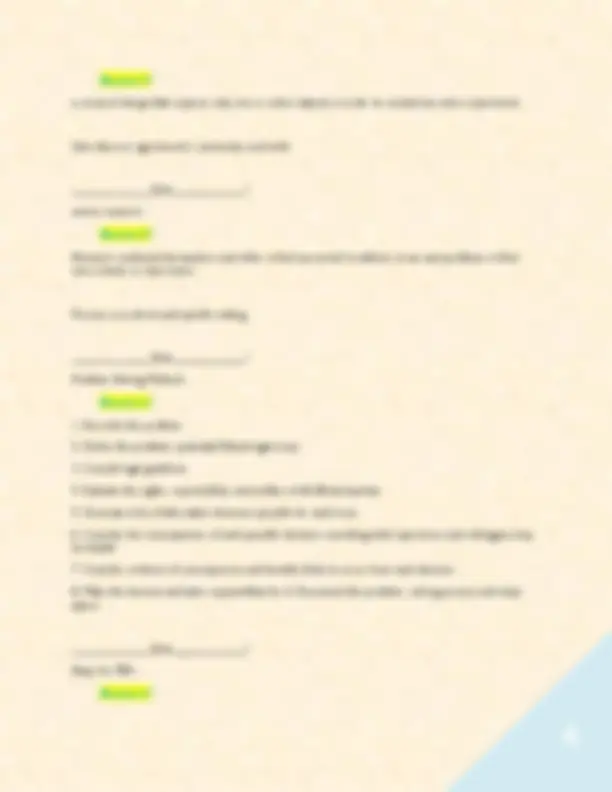

















Study with the several resources on Docsity

Earn points by helping other students or get them with a premium plan


Prepare for your exams
Study with the several resources on Docsity

Earn points to download
Earn points by helping other students or get them with a premium plan
Community
Ask the community for help and clear up your study doubts
Discover the best universities in your country according to Docsity users
Free resources
Download our free guides on studying techniques, anxiety management strategies, and thesis advice from Docsity tutors
PRAXIS 5403 / Actual Questions & Certified Solutions / Complete Accurate Quizzes with Verified Answers / 2025-2026 Terms in this set (96) _____________Quiz____________? IDEA - Answer✓✓ Passed in 1975 Guarantees all children with disabilities qualifying under its definitions a free and appropriate education (FAPRE0 I the east restrictive learning environment (LRE) Required transition plans in 1990 Took away discrepancy model in 2004 _____________Quiz____________? 4 Parts of IDEA - Answer✓✓ PART A: availability to all children with disabilities of a free appropriate education, protection of the rights of those children and their families, help federal agencies US states, educational service agencies, and local educational agencies provide for educating all children with disabilities PART B: provide funding to us states for delivering services to children and youth with disabilities PART C: Early intervention programs
Typology: Exams
1 / 23

This page cannot be seen from the preview
Don't miss anything!
















Terms in this set (96) _____________Quiz____________? IDEA -
Passed in 1975 Guarantees all children with disabilities qualifying under its definitions a free and appropriate education (FAPRE0 I the east restrictive learning environment (LRE) Required transition plans in 1990 Took away discrepancy model in 2004 _____________Quiz____________? 4 Parts of IDEA -
PART A: availability to all children with disabilities of a free appropriate education, protection of the rights of those children and their families, help federal agencies US states, educational service agencies, and local educational agencies provide for educating all children with disabilities PART B: provide funding to us states for delivering services to children and youth with disabilities PART C: Early intervention programs for infants and toddlers with disabilities PART D: Inform professionals and families of research and information including parent training and information (PTI) center operation, identifying best and promising practice teacher education, technology development, and public information dissemination _____________Quiz____________?
definition under this law of disabilities is a physical or mental impairment that interferes significantly with major life activities, even with the assistance of aids, devices, or medications _____________Quiz____________? FERPA -
Parent rights to inspect/ review children's educational records post-secondary student rights to inspect/ review records, parental rights to challenge educational records content, right to consent to educational records disclosure _____________Quiz____________? PARC vs. commonwealth of PA -
FAPE for all kids 6-21 regardless of degree of impairment *happened along side Mills vs. Board Ed _____________Quiz____________? Lau vs. Nichols -
Supreme Court rule that schools that do not provide special help for children with limited English are limiting their civil rights.This is landmark legislation for bilingual education in the U.S.(1974). The Supreme Court ruled that school districts must help non-English speaking students learn English. _____________Quiz____________? Hendrick Hudson Central School vs. Rowley -
Deaf student who was denied additional sign- language interpreter Court decided she was not receiving FAPE, defined as equal opportunity to achieve her full potential
a research design that requires only one or a few subjects in order to conduct an entire experiment Interobserver agreement is commonly used with _____________Quiz____________? action research -
Research conducted by teachers and other school personnel to address issues and problems in their own schools or classrooms. Focuses on a direct and specific setting _____________Quiz____________? Problem Solving Method -
A time sampling method for measuring behavior in which the observation period is divided into a series of brief time intervals (typically from 5 to 15 seconds). At the end of each interval, the observer records whether the target behavior occurred throughout the entire interval; tends to underestimate the proportion of the observation period that many behaviors actually occurred. _____________Quiz____________? Frequency/Event Recording -
a method of collecting data on a student's target behavior that is discrete and countable within a specified time period. Number of behaviors that occurred through out the entire interval- count the number of occurances _____________Quiz____________? Duration Recording -
recording the elapsed time during which a behavior occurs amount of time between the initiation of a response and it's conclusion
_____________Quiz____________? Four Ethical Principles -
Principal 1: Respecting the dignity and rights or all persons Principal 2: Professional Competence and Responsibility Principal 3:Honesty and Integrity in Professional Relationships Principal 4: Responsibility to Schools, Families, Communities, the Profession, and Society _____________Quiz____________? Erikson's Psychosocial Stages of Development -
Trust vs. mistrust (infant) Autonomy vs. shame/doubt (2-3) Initiative vs. guilt (3-5) Elementary School Industry vs. inferiority (6-11) Elementary School Identity vs. role confusion (teenagers) Middle and High School Intimacy vs. isolation (young adulthood) High School/ College Generativity vs. stagnation (middle age) Ego integrity vs. despair (old age) _____________Quiz____________? Gordon Allport -
trait theory of personality; 3 levels of traits: cardinal, central, and secondary _____________Quiz____________? Hippocrates -
Posted the earliest theories of personality in the 5th century
Four "Humors" or bodily fluids _____________Quiz____________? William Sheldon -
theory that linked personality to physique on the grounds that both are governed by genetic endowment; endomorphic (large), mesomorphic (average), ectomorphic (skinny) _____________Quiz____________? A.D. Galen -
Expanded Hippocrates by specifying those dominated by blood and yellow bile _____________Quiz____________? Big 5 Personality Traits -
Standardized assessments intended to compare a student's performance with the performance of others _____________Quiz____________? Frued's 5 stages -
_____________Quiz____________? Lewis Terman -
revised Binet's IQ test and established norms for American children; tested group of young geniuses and followed in a longitudinal study that lasted beyond his own lifetime to show that high IQ does not necessarily lead to wonderful things in life _____________Quiz____________? David Wechsler -
Developed WAIS and WISC (IQ tests) ADDED NONVERBAL AS WELL AS VERBAL MEASURES _____________Quiz____________? Raymond Cattell -
Created culture-free intelligence test in 1949. In 1963 he identified the distinction between crystallized intelligence and fluid intelligence _____________Quiz____________? EF a student must use to succeed in school? -
_____________Quiz____________? What is most effective for developing phonemic awareness? -
combination of both oral and print teaching _____________Quiz____________? Maslow's Hierchy of Needs -
physiological, safety, social, esteem, self-actualization (top) _____________Quiz____________? Program Evaluation Approaches- Identified by Steele -
Can be used together in the same program evaluation
relating to, measuring, or measuring by the quantity of something rather than its quality. EASIER TO GENERALIZE FINDINGS
_____________Quiz____________? Categories of evidence that can be used to verify test validity? -
3 ring conception of giftedness
MID ID: between 40- 55
Mild ID: between 50- 70 Severe ID: between 25- 40 _____________Quiz____________? longitudinal research design -
Research in which individuals are studied over an extended period of time, often over multiple developmental stages. _____________Quiz____________? Cross-sectional design -
groups of people differing in age are studied at the same point in time _____________Quiz____________? cross-sequential design -
a combination of the longitudinal and cross-sectional designs _____________Quiz____________? Goals for school admin in implementing a safe school-wide plan -
Hippocampus -
The largest structure in the limbic system forming new explicit memories _____________Quiz____________? Hypothalamus -
a neural structure lying below the thalamus; directs eating, drinking, body temperature; helps govern the endocrine system via the pituitary gland, and is linked to emotion _____________Quiz____________? Cerebellum -
A large structure of the hindbrain that controls fine motor skills. _____________Quiz____________? Amygdala -
two lima bean-sized neural clusters in the limbic system; linked to emotion. _____________Quiz____________? frontal lobe -
associated with reasoning, planning, parts of speech, movement, emotions, and problem solving _____________Quiz____________? parietal lobe -
receives sensory input for touch and body position _____________Quiz____________? temporal lobe -
hearing _____________Quiz____________? occipital lobe -
vision _____________Quiz____________? Wernicke's aphasia -
inability to comprehend speech can't understand what you say _____________Quiz____________? Pavlov -
classical conditioning _____________Quiz____________? operant conditioning -
Learning based on the consequences of responding.
Humanisic; self-concept and unconditional positive regard drive personality Pioneered person-centered or client-centered therapy _____________Quiz____________? Albert Bandura -
researcher famous for work in observational or social learning including the famous Bobo doll experiment self-efficiancy _____________Quiz____________? Walter Mischel -
Believes human behavior is largely determined by the situation rather than trait encoding. expectancies, beliefs- these things determine how a person behaves in a given situation _____________Quiz____________? Nancy Cantor -
proposed the cognitive prototype approach in which cognitive behavior (such as the formulation of and attention to prototypes) is examined in social situations 3 dimensions: life goals, knowledge relevant to social interactions, and strategies for implementing goals 3 interactions form different behavior patterns that from personality _____________Quiz____________? Batsons Motivations for Pro-Social Behavior -
Altruism: acting for the benefit of others Egoism: helping others to benefit oneself Collectivism: helping for the benefit of a group (family, political party, etc.) _____________Quiz____________? Spearman -
proposed that general intelligence is linked to many clusters that can be analyzed by factor analysis (he made up factor analysis) _____________Quiz____________? Gardner -
Theory of multiple intelligences *Cattell used factor analysis to conclude spearman's idea *Sternberg formulated the triarchic therapy of intelligence _____________Quiz____________? Noam Chomsky -